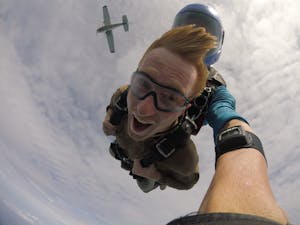7 Myths about Skydiving Safety

Have you ever felt the thrill of freefall or the gentle pull of a parachute guiding you back to earth? Or perhaps these experiences are still lingering on your bucket list, kept at bay by the hovering cloud of safety concerns. The questions are always there – how safe is skydiving ? Are the risks worth the adrenaline rush? This blog post is dedicated to dispelling the common myths surrounding the safety of skydiving and providing you with the truth you need to make an informed decision. So, let’s jump in!
MYTH 1: SKYDIVING IS MORE DANGEROUS THAN DRIVING
It’s understandable to perceive skydiving, an activity involving jumping from thousands of feet in the air, as incredibly risky. This belief, however, crumbles when pitted against actual statistical data. Let’s delve into this a bit further.
According to the United States Parachute Association (USPA), in 2019, approximately 3.3 million jumps were made. Out of these, there were only 15 fatal skydiving accidents. This data equates to 0.00045% chance of a fatal incident in skydiving.
Now, let’s compare this with something that most of us do every day – driving. The National Safety Council, a US-based non-profit organization dedicated to promoting health and safety in the country, reports a 1 in 114 chance of dying in a motor vehicle crash. The contrast is stark.
Despite the perception, statistically speaking, an everyday activity like driving to work poses a significantly higher risk than skydiving. It’s essential to bear in mind that every sport or activity has its inherent risks, and skydiving is no exception. However, these risks are extensively mitigated through rigorous safety measures, protocols, and continuous improvements in equipment and training standards in the industry.
The understanding of these figures isn’t intended to instill fear of driving, but rather to bring perspective to the relative risks involved in different activities. It underlines the importance of diligent safety practices, no matter what we’re doing – be it driving, skydiving, or anything else.
So next time you think about skydiving, remember that while it may sound more dangerous than your daily commute, the numbers tell a different story.
MYTH 2: SKYDIVING EQUIPMENT OFTEN FAILS
Many people hold the misconception that skydiving equipment is prone to failure, conjuring visions of parachutes refusing to open at the crucial moment. However, this could not be further from the truth. Skydiving equipment, like any other field where safety is paramount, is subject to meticulous checks, regulations, and maintenance.
Let’s start with the parachute system. Each system is dual-parachute, featuring both a main and a reserve parachute. But it doesn’t stop there. There’s also a device called an Automatic Activation Device (AAD) incorporated into the gear. This piece of tech marvel is designed to automatically deploy the reserve parachute if the skydiver is unable to do it themselves for any reason. This triple-layered safety net contributes immensely to ensuring each skydivers safety.
Now, onto the maintenance part. Every reserve parachute undergoes inspection and repacking every 180 days by a certified parachute rigger. This is a non-negotiable rule set forth by the Federal Aviation Administration (FAA), irrespective of whether the reserve parachute has been used or not. This meticulous attention to regular maintenance and adherence to rules ensures that the equipment is always in the best possible condition for a skydive.
These rigorous maintenance schedules and multiple fail-safes work in unison for the safety of every skydiver. While nothing is guaranteed safe (especially skydiving) the redundancy in the equipment to the attention to detail during inspections, every aspect of skydiving gear maintenance aims to dispel the myth of equipment failure and promote a safe, secure, and memorable skydiving experience.
MYTH 3: NOVICE SKYDIVERS ARE AT HIGH RISK
If you’re a first-time skydiver, you might think that your inexperience puts you in the high-risk zone. But here’s the fact: skydiving is designed in such a way that novices can enjoy the exhilarating experience under the safe guidance of experts.
Your first jump will almost certainly be a tandem skydive. What does that mean? It means you will be securely harnessed to a professional tandem instructor for the entire duration of the jump. These are not just any professionals – these are instructors who have completed hundreds, often thousands of skydives. They’re trained rigorously and tested thoroughly before they get the nod to guide tandem jumps.
Your instructor’s job doesn’t stop with just jumping out of the aircraft with you. They’re there to handle every phase of the jump, from the exit, through the freefall, to piloting the parachute, and finally, the landing. They’re trained to handle a multitude of scenarios that might occur during the jump. As a novice skydiver, you’re in good hands. Your instructor will guide you through the entire process, ensuring not just your safety, but also helping you truly enjoy this exhilarating experience.
So, as a beginner, you’re not at a higher risk. Instead, you’re stepping into an adventure where every detail has been organized to prioritize your safety while making sure you have the time of your life.
MYTH 4: SKYDIVING IS ONLY FOR ADRENALINE JUNKIES
Skydiving is often painted as the playground for adrenaline junkies, and while the sport does offer a hearty rush of adrenaline, it is a misconception that it’s exclusively for thrill-seekers. In fact, skydiving transcends the barriers of age, personality, and background, providing a unique space for personal development and emotional growth.
Skydiving can indeed be a cathartic experience, allowing individuals to confront and conquer their fears. It’s a moment where the noise of the world fades away, and one comes face to face with their own courage and determination. And when they land back on the ground, they are often not the same person who took off – they’ve grown, broken personal barriers, and gained a newfound sense of self-confidence.
Moreover, amidst the rush of the freefall, there’s a unique tranquility and a sense of connection with the vast expanse of nature around you. Many skydivers describe it as a form of meditation in motion, where one feels a profound connection with the universe.
Lastly, skydiving can also be a powerful tool for achieving personal milestones. Whether it’s a celebration of a significant birthday, overcoming a personal loss, or simply challenging oneself to step out of their comfort zone, every skydive can be a deeply personal and transformative experience.
So, whether you are an adrenaline junkie, a silent observer, an introspective soul, or someone just looking for an out-of-the-box experience, skydiving can cater to you all. It’s not just a sport – it’s a journey of self-discovery and personal growth.
MYTH 5: ALL SKYDIVING COMPANIES HAVE SIMILAR SAFETY RECORDS
It’s a common misconception that all skydiving companies adhere to the same safety standards and, therefore, have similar safety records. This couldn’t be further from the truth. Just like in any other industry, there can be a wide disparity in safety standards and practices among different skydiving operators.
Some companies go above and beyond to prioritize safety. They invest heavily in regular and rigorous equipment maintenance, thorough training for their staff, and strict adherence to all safety regulations set by the United States Parachute Association (USPA) and Federal Aviation Administration (FAA). These safety-first companies view every aspect of the operation through the lens of safety, from the moment you arrive for training until you’ve landed safely back on the ground.
On the other hand, there are companies that may cut corners or prioritize other aspects of their business over safety. The resulting discrepancies in safety standards can, unfortunately, reflect in their safety records.
When choosing a skydiving company, it’s crucial that you do your homework. Look at their safety record, read customer reviews, and verify their accreditation with recognized industry bodies like the USPA and work with certified mechanics to make sure things are working like they should. Check the experience level of their instructors and their commitment to regular equipment maintenance and updates. A company’s proactive commitment to safety can significantly enhance your skydiving experience, providing you with peace of mind and allowing you to fully enjoy the thrill of the jump.
Remember, safety isn’t an area where you want to compromise. Choosing a skydiving company with a stellar safety record can make all the difference between a remarkable, once-in-a-lifetime experience and an unpleasant one.
MYTH 6: EXTREME WEATHER MAKES SKYDIVING UNSAFE
The myth that extreme weather makes skydiving unsafe stems from a misunderstanding of how carefully skydiving operations monitor and respond to weather conditions. It’s true that weather can influence the safety of a skydive – but that’s exactly why the industry has strict rules and procedures in place for assessing weather conditions.
Skydiving operators do not leave the weather to chance. They meticulously monitor weather patterns, using sophisticated technology and consulting with meteorological sources. They evaluate factors like wind speed, wind direction, temperature, visibility, and potential for adverse conditions like thunderstorms or excessive cloud cover.
The general rule is, if the weather could compromise safety or the ability to fly, the jump will not proceed. If the wind is too strong or gusty, the sky too cloudy, or the visibility too poor, jumps will be postponed or cancelled outright. This is because safety is the absolute priority in skydiving, even over the excitement of the jump itself.
Skydivers, especially first-timers, can take comfort in the fact that weather-related decisions are made by professionals who are trained to understand the effects of various weather conditions on skydiving safety. Skydiving is not just about the thrill of the free fall or the beauty of the view. It is about conducting each and every jump under the safest conditions possible. So, while weather is an important factor, it is one that is handled with extreme care in the skydiving world.
MYTH 7: FEAR MAKES SKYDIVING UNSAFE
When it comes to skydiving, fear is often considered the elephant in the room. It’s not uncommon to feel a wave of fear or anxiety as the airplane ascends and the moment of the jump draws near. But does this fear make skydiving unsafe? Absolutely not.
Fear, at its core, is a protective mechanism designed to alert us to potential danger. When skydiving, this fear may be amplified due to the unfamiliarity and perceived danger of the situation. However, it’s crucial to understand that this emotional response does not inherently compromise safety.
Instructors are not only experts in skydiving, they’re also well-versed in managing fear. They understand the psychology of fear and understand that people forget things in the briefing to help you navigate the experience. Before each jump, they ensure you feel as comfortable and prepared as possible. They’ll answer your questions, offer reassurances, and provide clear instructions to help you manage your anxieties.
Moreover, overcoming this fear can become a rewarding part of your skydiving experience. There’s something incredibly empowering about facing your fear head-on, pushing through it, and emerging triumphant on the other side. This can be a significant part of the personal growth many people experience through skydiving.
So while fear is a normal part of the skydiving experience, it does not make the activity unsafe. In fact, with the guidance of experienced instructors, confronting and overcoming your fear can become one of the most satisfying aspects of your skydive. It’s not just about the thrill of the jump, but also about the personal victory over fear.
CONCLUSION
We’ve explored and busted some of the common myths about skydiving safety. From stringent equipment checks to meticulously monitoring weather conditions and the presence of experienced instructors, it’s clear that safety is a top priority in skydiving operations. Remember, skydiving isn’t just for adrenaline junkies – it’s an opportunity for personal growth, overcoming fears, and experiencing something truly extraordinary. Don’t let unfounded myths hold you back. Gear up, educate yourself, choose a reputable company, like Skydive East TN, and get ready for the ride of your life!
